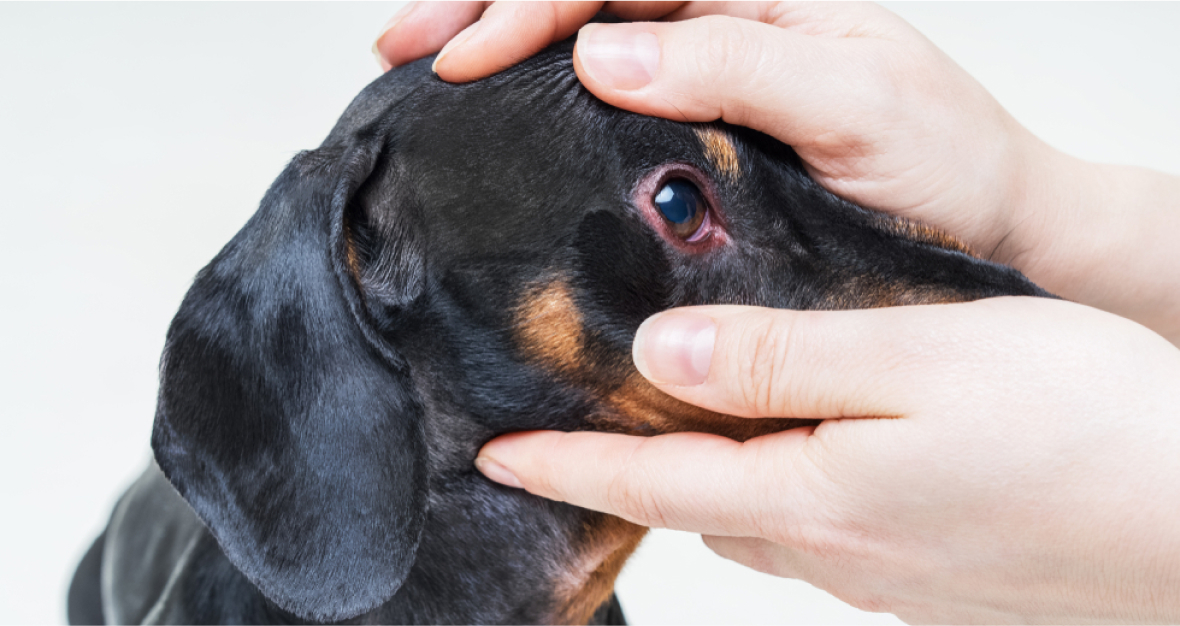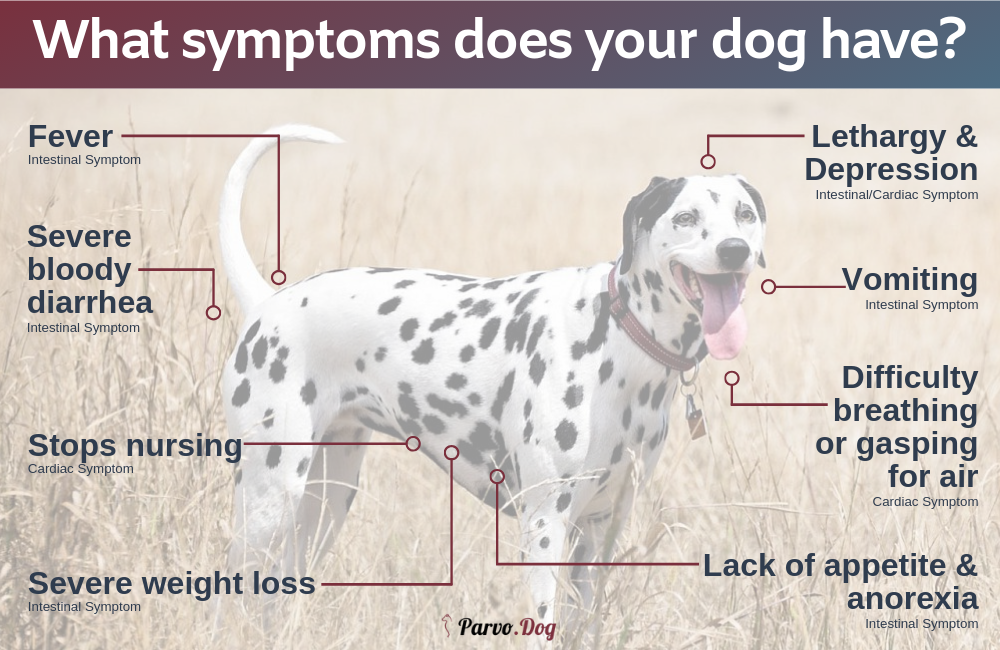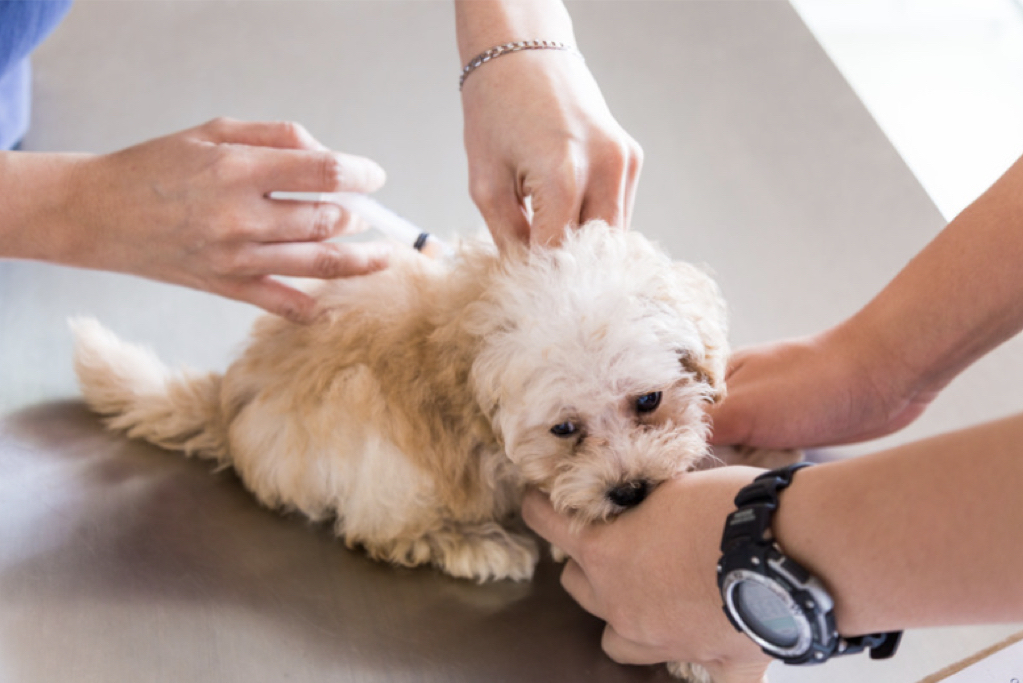Signs & Symptoms

Canine Parvovirus is one of the most dangerous illnesses that a dog can contract. Unlike other viruses, the Parvovirus is rapid in production, and so is the onset of symptoms.
It is critical to understand how Parvo presents itself in dogs to recognize them in your most beloved furry friend. Both the intestinal and the cardiac forms of the disease have their own set of symptoms, and appear differently from one dog to another.
What It Looks Like
The disease typically takes about 3-10 days after infection before the dog begins to show signs of Parvovirus. It is an acute illness, meaning that symptoms will show up very soon after exposure.
If left untreated, the disease can cause death within a couple of days of the onset symptoms (Healthcommunities, 2007). Below you will find a list of signs and symptoms for each form of the virus.
Diarrhea and vomiting do not always mean your dog has Parvo. It is crucial to bring your dog to the veterinarian to confirm a diagnosis.
Cardiac & Intestinal Symptoms
- Cold extremities (arms and legs)
- Gasping for air or rapid breathing while exercising or running around
- Convulsions
- Very sudden heart failure with respiratory complications (typically occurs in puppies between 4 and 8 weeks of age)
- Swollen abdomen due to an enlarged liver


Because Cardiac Parvovirus attacks the heart, diarrhea may not always be a symptom. The virus multiplies in the heart and does not typically impact the intestines. Lesions may occur on the heart muscles, and the lungs may produce a white and frothy liquid present in the trachea and bronchi (Nandi and Kumar, 2010).
On the other hand, intestinal Parvovirus itself does not directly cause death. Instead, it causes a loss of the lining in the intestines, which damages the gastrointestinal tract. When the gastrointestinal tract is damaged, the small intestine can become soft and limp. \
The wounds often present in areas where there is rapid cell production, and the structures in the intestines used to absorb nutrients and fluids may collapse completely. The loss of these structures can often lead to severe diarrhea.
It is vital to observe the dog’s stool should they have diarrhea. The consistency and characteristics of a dog’s feces may not always be the same. The stool can vary from being watery, yellow, or even bloody. As a result of diarrhea and vomiting, rapid fluid loss is an immediate concern and leads to dehydration. If your dog is experiencing frequent diarrhea, it may be helpful to use dog diapers to keep your home clean.
Diagnosis
If you notice any of the above symptoms, please take your dog to the veterinarian immediately. Canine Parvovirus is diagnosed based on the signs symptoms that are displayed, typically paired with laboratory testing to confirm the diagnosis.
Your vet will first perform a routine physical check-up and look at your dog’s comprehensive medical history. Checking your dog’s medical history will help them understand the vaccines, treatments, and other medical-related visits for your pet.
It is important to note that your dog might not have Parvo just because they are experiencing vomiting and diarrhea. However, it is still recommended to have your pet checked to rule this possibility out.
To conclusively determine whether your dog has the virus, the veterinarian will conduct the following tests:
Urine Analysis
A urine test may uncover electrolyte imbalances and could reveal any elevated liver enzymes. The test also screens for low lymphocytes count (white blood cells), which fight off foreign matter and illnesses. A reduced number of lymphocytes is an indicator that a dog does have Canine Parvovirus.
White Blood Cell Count
A complete blood cell count will look at the number of white blood cells in a dog’s body, in addition to looking for Parvovirus antibodies. A low count of white blood cells is a good indicator of the disease, as white blood cells are the body’s defense against foreign pathogens. Parvovirus weakens the dog’s ability to protect itself by destroying immune cells.
Abdominal X-Rays
An X-ray provides a picture of a dog’s body internally. A vet can perform an X-ray to rule out other causes of gastrointestinal issues besides Parvo, such as an obstruction or foreign object in the intestines. An abdominal ultrasound could also potentially reveal fluid build-up.
ELISA Test
An ELISA test determines whether the virus is present in a dog’s fecal matter. ELISA stands for enzyme-linked immunosorbent assay, one of the most common tests used to diagnose Parvo.
The technician places Parvo antibodies into a testing chamber along with a stool sample. The antibodies attach to the virus if it is present in the feces and a color-changing agent is added, which will change color if the test is positive (Cornell University College of Veterinary Medicine, 2018).
- A positive ELISA test in an animal presenting clinical symptoms is considered positive.
- A negative ELISA test in an animal presenting clinical symptoms is still considered positive.
- A positive ELISA test in addition to a low complete blood cell count is considered positive.
- A negative ELISA test is considered negative for Parvovirus.
Electron Microscopy, Tissue Culture, and Viral Isolation
These are more advanced tests to determine the presence of Parvovirus. However, most dog owners prefer to treat the disease rather than spend on the tests because they are expensive. (Petwave).
Each of these evaluations listed above produces different information. Experts recommended that a combination of all of these tests be performed. If the doctors find that your dog does have Parvo, the dog will most likely have a weakened immune system and will be much more susceptible to other diseases.
It is prudent to ask your veterinarian how to protect your dog from getting sick and boost their immune system back up.


Top 5 Frequently Asked Questions
Parvo symptoms usually present themselves within 3-10 days after infection.
A dog can recover from Parvo in about a week if given the proper care and treatment. However, they are still considered infectious for up to six weeks as the dog’s body is still shedding the virus.
The first vaccine that your puppy will get will be at six weeks old, and then the next shot will be administered in two to four-week intervals. There are typically three shots total, and then a booster shot is administered one year later and then again every three years. For adult dogs or pups over 16 weeks old, there are typically two vaccines administered three to four weeks apart. Experts recommend continued vaccination every three years.
Your dog has the best chance of being protected from the virus after they receive a complete round of vaccines. Limit your dog’s exposure to areas where there are lots of dogs confined in small spaces, such as dog parks, pet stores, etc.
The virus does not always have a distinct smell, but it may cause very foul-smelling diarrhea that is generally associated with blood and/or mucus in the feces.
After treatment, a dog can continuously shed the virus for up to six weeks, however, a dog may not still be showing any signs or symptoms of the disease during that time.




